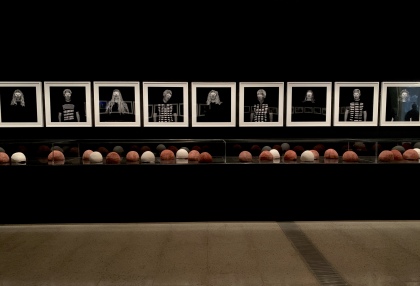Submitted Review
‘…ideology behind a practice that continually tests the capacities of body and machine.’
Blanche Tilden: 'Ripple Effect' a 25 year survey
Geelong Gallery celebrates 25 years of contemporary jeweller Blanche Tilden’s practice with an impressive survey exhibition featuring new and historical works from public and private collections. Its title, Ripple Effect, references the beauty of Tilden’s layered and fluid works, but more significantly, acknowledges the iterative and generative qualities of her jewellery practice, kept thriving by an inimitable work ethic.
Centred in the first of two exhibition spaces is Ripple Effect’s titular piece, a series of seven neckpieces featuring salvaged glass lenses, meticulously crafted with sterling silver and gold. The surrounding exhibition mimics rippling waves undulating outwards from this central work. A successfully understated exhibition design, this layout avoids a prescriptive chronological or thematic engagement, instead encouraging intuitive movement throughout the space. Such a generous survey of work offers many entry points to understanding Tilden’s practice; however, most compelling is the artist’s technical and conceptual engagement with her signature materials of industrial glass and metal.
Tilden’s technical evolution with material is traced from early pieces such as Triangle Black and Blue 1991 and Parallel 1995, through to more recent works such as Flow 03 2016 and Circularity 2017. This skill, honed over decades of rigorous process and thoughtful engagement with technology, transforms industrial materials into beautifully resolved jewellery pieces. We gain insight into Tilden’s cultural and historical influences over this time with pieces such as Brunel 2010 and Dutert 2012, referencing 19th century giants of architecture and engineering. On the more humble end of the industrial spectrum, Tilden celebrates the beauty of ubiquitous machine components with Sliding Pulley 1997, Pulley 1998 and her bicycle chain pieces. Such works indicate the meeting of human discipline and machine precision as both philosophical and technical inspirations for Tilden; an industrial-age work ethic embedded in a creative practice. The harder I work, the luckier I get 2012, a piece made from a salvaged mild steel file, silver and gold, suggests the ideology behind a practice that continually tests the capacities of body and machine.
Moving into the second gallery, we encounter a disruption in the rippled design of the central exhibition space. Photographic portraits of collectors proudly wearing Tilden’s work line one wall, establishing symmetry with neckpieces hanging opposite. Outstretched on a table running the length of the gallery is the five-metre Long Conveyor II 2020-2021, the second version of a work created for Tilden’s first solo exhibition at Gallery Funaki in 1997. The making of this remarkable piece is detailed in a short video screening at the entrance of the gallery space. In a production line of her own making, Tilden hand-cuts and flameworks glass tubing into cylindrical beads, later riveting them with hand-made silver and machined titanium components to create the conveyor form.
Adjacent to the installation is a portrait of Tilden with Long Conveyor II elegantly draped around her. The conveyor belt—so familiar in parodies of industrialised labour and critiques of modernism’s alienation—is lovingly hand-assembled and reimagined as an object for the human body, not despite it. Like many works in Ripple Effect, Long Conveyor II illuminates what makes Tilden’s practice significant amongst contemporary makers. Her work possesses the integrity of the handmade without trading in artisanal romanticism. And while engaging with industrial processes and aesthetics, she handles technological affordances with shrewd selection. Far from being a cog in the machine, Tilden strikes a masterful balance with her considered approach to human-machine collaboration.











No Comments